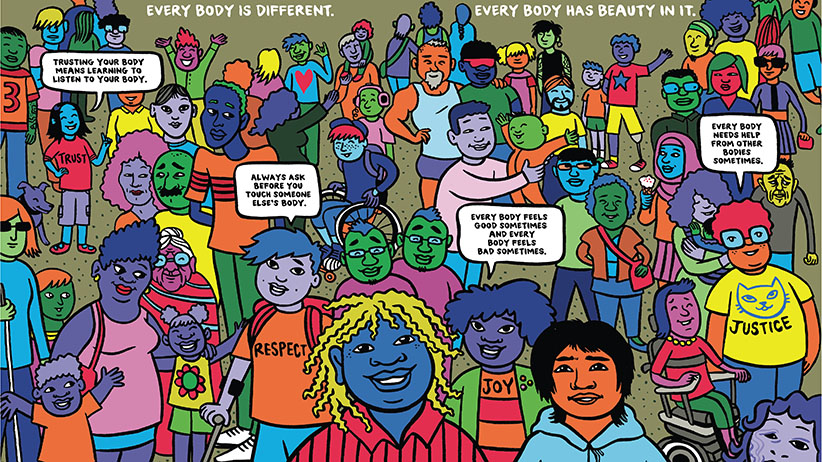
Finally, inclusive children’s sex ed books
What do sex ed books for kids look like without assumptions about gender, sexuality, race, size, and ability? They look a lot like Cory Silverberg’s What Makes a Baby and Sex is a Funny Word.
Being inclusive means never showing a whole body naked from head to toe. It means conditional words such as “some,” “most,” “usually,” and “often” — not absolutes. It means giving the clitoris and the penis an equal word count. It means not attaching the words “woman” and “man” (or “mommy” and “daddy”) to specific types of bodies. It means leaving space for discussion. It means illustrations that present a world of color, of joy, and of difference.
It means moving beyond a man with sperm, a woman with eggs, and a bed with intercourse.
In an interview with Kveller, Silverberg explains the ending of What Makes a Baby, which reads, “who was waiting for you to be born?”
That idea grew out of a conversation with a woman who adopted her daughter on her own. We were talking about how long she waited for this baby, this baby she didn’t know but she spent literally years imagining. That act of imagination is an act of love. And it is no less powerful or important than the parent who is pregnant and waiting nine months for their child to be born. Most of the time we give all the credit to parents who get pregnant and deliver their children. I wanted to end the book in a way that honors all parents who love their kids regardless of the role they had in the biological baby making part.
Sex educator Cory Silverberg was the perfect person to write these books. His mom was a feminist and a children’s librarian; his dad was a sex therapist. Growing up, there was no word for how he felt — except “outsider.” Now he identifies as queer. In 1997, he co-founded Come As You Are, a cooperatively-run feminist sex shop in Toronto. In 2007, he co-wrote The Ultimate Guide to Sex and Disability, and since 2005 he has served as the Sexuality Guide for About.com.
What Makes a Baby was inspired by one of Silverberg’s friends, a trans dad who was not biologically related to his children. One day he asked Silverberg, “what is the least bad book you can recommend, or better: have you written yours yet?” The masses also desperately wanted an inclusive children’s sex ed book, as evidenced by the book’s wildly successful crowdfunding campaign. Donations exceeded the project’s initial goal by over $50,000.
Silverberg’s second children’s book, Sex is a Funny Word, was just released. This one is geared toward children ages 8 to 10. In interviews with The Hairpin and Lambda Literary, Silverberg discusses his upbringing, what it’s like to collaborate with illustrator Fiona Smyth, and why he avoids giving definitive advice in his books He also talks about the challenges of writing and illustrating Sex is a Funny Word, particularly in the chapter about masturbation:
We were really struggling with how to illustrate it. I didn’t want a hands-down-the-pants picture. For one thing, masturbation isn’t just about touching your genitals, but I also didn’t want anything explicitly sexual in a book for seven-to-10-year-olds. Fiona came up with the image of each kid having a biodome that represented their bodies and their sensations, with places like Tickle Country and Sore Valley, which brilliantly conveys the point that through exploring your own body you are going to learn all sorts of things about it and how it feels.
A third book is in the works, which will complete the trilogy and offer inclusive sex information to children 10 and up. To follow along, become a fan of the books on Facebook. Plus, check out Cory Silverberg’s recent interview on Tristan Taormino’s Sex Out Loud Radio, in which Taormino calls Sex is a Funny Word “one of the most inclusive books I’ve ever read on any subject for any audience.”
